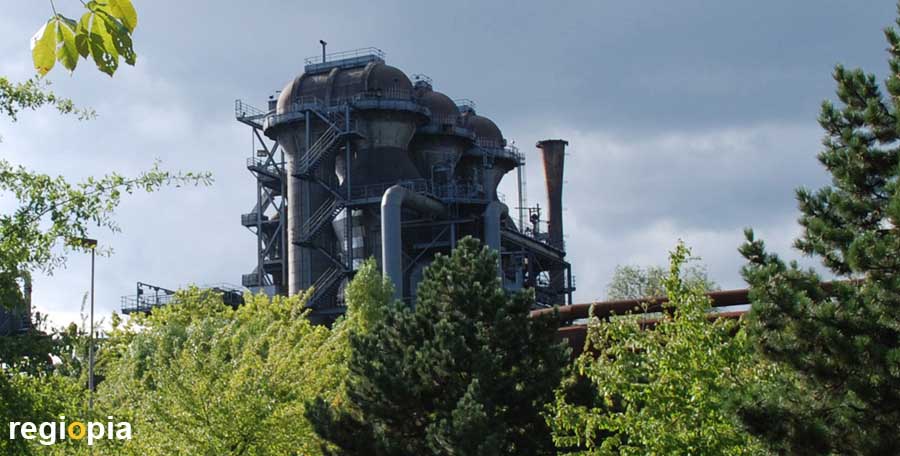
Landschaftspark Duisburg Nord
The former Thyssen steelworks in Duisburg-Meiderich has become an interesting culture and nature experiment. The old industrial buildings are slowly being overgrown by plants. The Landschaftspark Duisburg Nord was a project of the IBA Emscher Park that was implemented in 1990. The ironworks were shut down in 1985 and redesigned according to the plans of landscape architects Peter Latz + Partner. The industrial character of the plant was preserved and plants were selected that could survive on the poor soil. The Duisburg North Landscape Park was opened in 1994. It is the most famous IBA project. The combination of industrial ruins, exhibition hall and landscape park with gastonomy makes Duisburg Nord unique. The park became world famous through spectacular night photographs with colored light installations.
What is there to discover?
Event rooms and exhibition spaces are located in the Kraftzentrale building. There is a viewing platform on blast furnace Hochofen 5. There is a diving center in the Gasometer. The former ore storage was converted into a climbing garden. Entry to the site is free of charge. Events and tours are subject to a fee, see link below.
How do you get there?
There is a visitor car park on Emscherstrasse. Tram line 903 runs from Duisburg main station to the "Landschaftspark Nord" station. It's about a 10-minute walk from the station to the entrance.
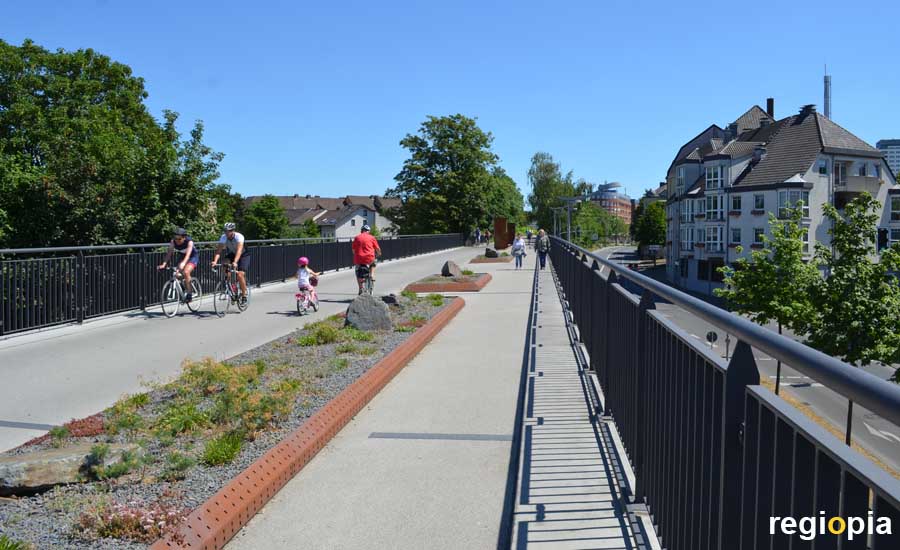
Radschnellweg Ruhr RS1
The Radschnellweg Ruhr RS1 is a bicycle highway through the Ruhr area. The 100-kilometer route runs from Duisburg to Hamm. In 2015 the first section of the RS1 was opened between Mühlheim an der Ruhr and Essen. The approximately 6-kilometer section is located between the Garden on the Ruhr in Mühlheim and Essen's Niederfeldsee. On the photo you can see the city viaduct in Mühlheim.
The cycle expressway runs without crossings. The 4 m wide bike path is always separated from the pedestrian path, except at few narrow spots. This makes the cycle track very quick to move forward. Gradients were kept as low as possible but there are some. The Ruhr area is not a flat land, you should use a bicycle with gears. The Radschnellweg Ruhr is very well adopted, many commuters use the bike path on the way to work. On weekends it can get crowded on the RS1.
In the future, the entire route will be paved and illuminated. Service stations and winter service should keep the cycle path accessible even in winter. Further sections are under construction or in planning.
www.rvr.ruhr/themen/mobilitaet/radschnellwege-ruhr
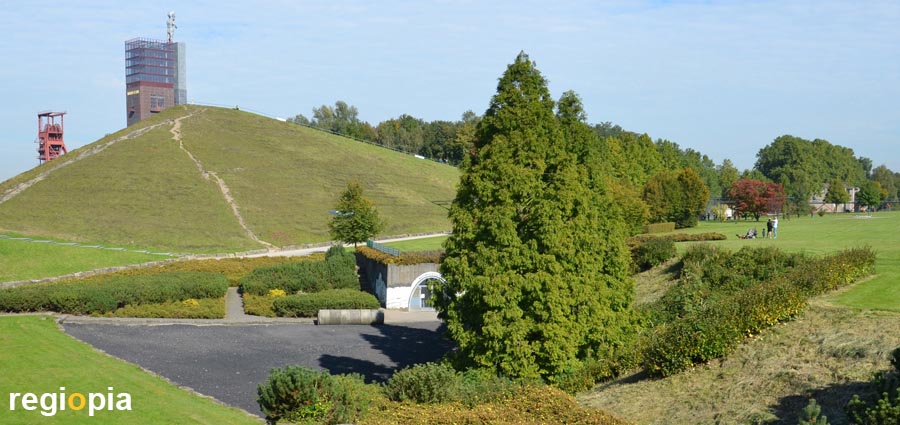
Nordstern Park
The Nordsternpark is located in the Horst district of Gelsenkirchen. The Nordstern hard coal mine began producing coal in 1868. The plant was continuously expanded until the decline begins in 1980. After the Nordstern colliery was finally closed in 1993, a landscape park was created on the site. In 1997 the Federal Garden Show (Buga) took place here. Old colliery buildings were integrated into the park. The Nordsternpark is located directly on the Emscher and the Rhine-Herne Canal. An amphitheater was also built right on the water. The attractions in the park include the landscape pyramid and the red double arch bridge over the Rhine-Herne Canal by civil engineer Stefan Polonyi.
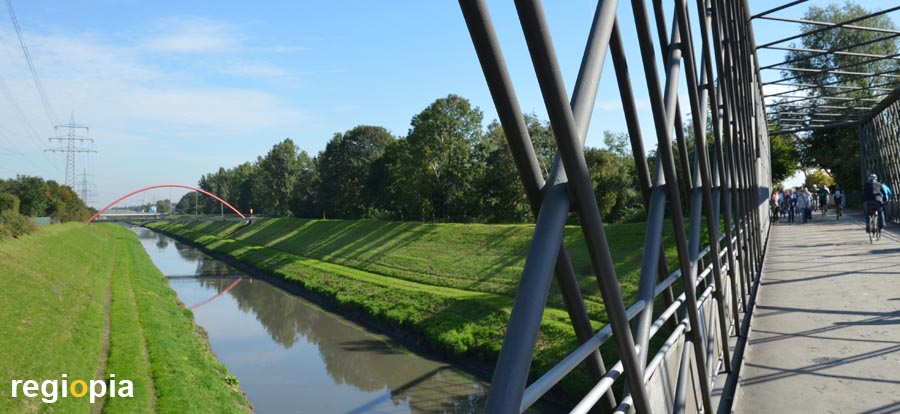
Emscher Park cycle path
The International Building Exhibition IBA Emscher Park initiated many projects to transform former industrial areas into parks between 1999 and 2009. The Emscher Park bike path connects many projects of the Route of industrial culture along the river. For a long time, the Emscher served as a sewer for industry and was a highly polluted body of water. It originates in Holzwickede, an eastern suburb of Dortmund and flows into the Rhine at Dinslaken after around 83 kilometers. The Emscher Park cycle path is a 230 km bicycle route that circles the Ruhr area from Duisburg to Hamm. The circuit only partially runs along the Emscher, which often runs parallel to the Rhine-Herne Canal.
The most interesting part is between the Oberhausen Gasometer and the Nordsternpark in Gelsenkirchen. Between these two stations, the cycle path turns north and passes the Tetrahedron and the alpine center in Bottrop. The bike route between Gasometer and Nordsternpark measures around 15 kilometers. The "Route of Industrial Culture" is one of the most famous leisure destinations in the Ruhr area and is well signposted, here you will also find numerous restaurants, industrial buildings and museums. The photo shows the section at Nordsternpark.
www.route-industriekultur.ruhr/route-per-rad.html
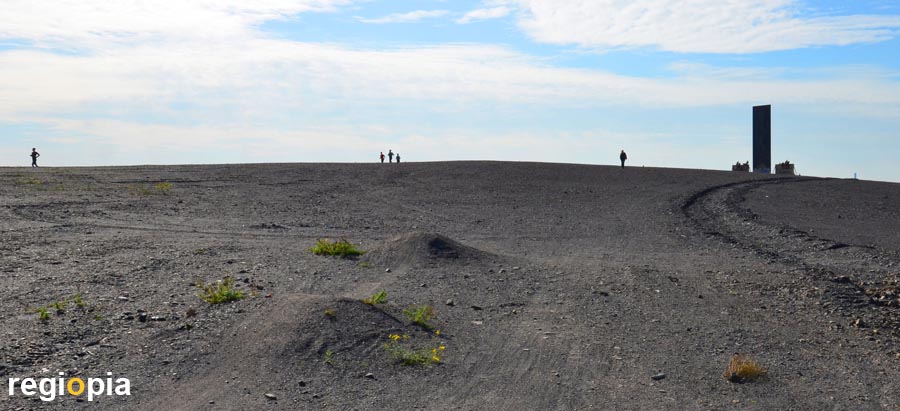
Schurenbachhalde
The lunar landscape on the summit of the Schurenbachhalde stands in contrast to the lush, green forest landscape that you cross when climbing the heap. The former hard coal waste dump was renatured in the 1980s with 250,000 trees. The Schurenbachhalde rises about 50 m above the surrounding area in the north of Essen. Stairs and paths lead up to the summit, on which the landart sculpture Bramme by Richard Serra is located. The Ruhr area is at no other place better understood than here. You can see the man-made desert but also the green landscape that has now overgrown the industrial area.
How to get there
There is no visitor parking lot, if you come by car you have to look for a parking space nearby. The underground station Heßlerstraße is only 800 m in linear distance from the summit. Follow Heßlerstraße for around 400 m until Fritzstraße, turn left and after another 200 m you are at the foot of the Schurenbachhalde. Then you follow the paths that lead upward.
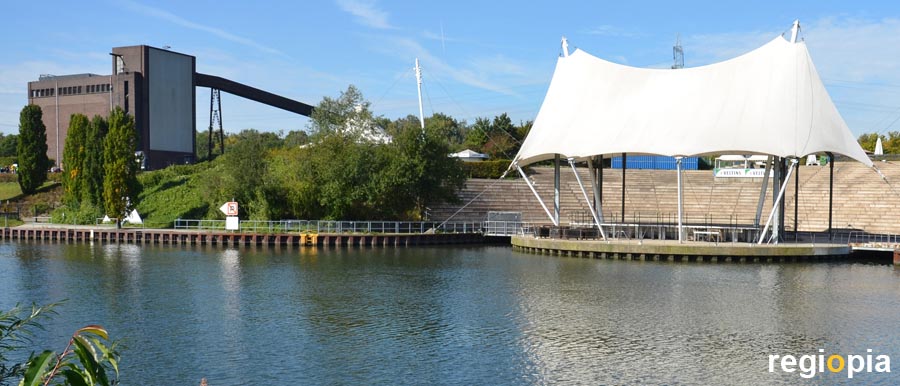
Rhein-Herne-Kanal
The Rhine-Herne Canal was opened in 1914 for the transportation of coal. After the mines were shut down, the canal lost its function and is only used by a few ships. At the European Capital of Culture in 2010, the Rhine-Herne Canal became the Culture Canal. Cultural and leisure projects along the canal were promoted. Since then, the canal has been a popular recreation area with bike paths and an open-air stage right on the water in Gelsenkirchen. The Rhine-Herne Canal begins in the east at the Henrichenburg boat lift, the transition to the Dortmund-Ems Canal. At Duisburg the canal flows into the Rhine.
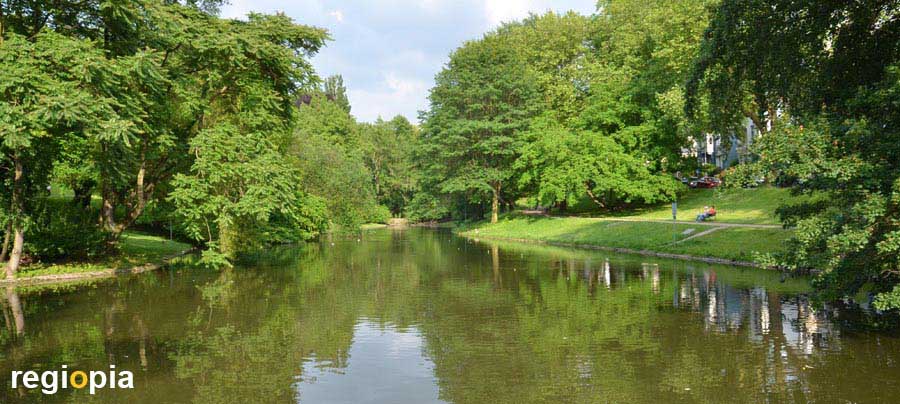
Stadtpark Bochum
The city park in Bochum was created in 1876 in the style of an English landscape garden. The hilly area with two lakes and a "bismark tower" built 1910, is a paradise for rabbits. The cute little rabbits can be seen bouncing around the park. There is also a little zoo at the city park. Bochum's city park is north of the city center. Nearby is the art museum and the planetarium.
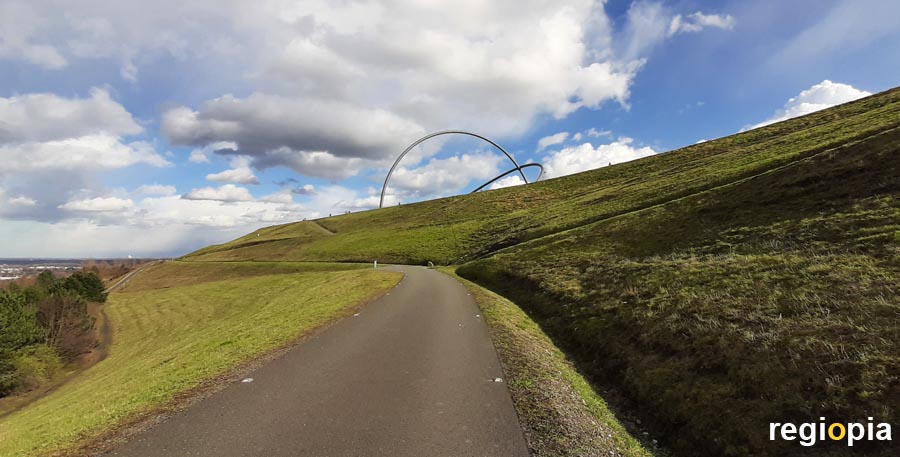
Halde Hoheward
The Hoheward heap was created by the overburden of the mines Zeche Ewald and Recklinghausen II. The mountd is located in the urban area of the cities Herten and Recklinghausen. The heap was raised between 1980 and 2000. The highest point is 152 m above sea level. The heap thus rises above the surrounding area by around 80 m. The lower part of the heap was reforested while the upper part was only planted with grass. The horizontal observatory, a huge sculpture made of two steel tubes, stands on the summit plateau. Since cracks were found in the steel, the horizontal observatory has been cordoned off since 2008. It has not yet been clarified whether it will be renovated or demolished. From the summit you can see the center of the Ruhr area. On good days, you can even see the Rhine Tower in Düsseldorf. There is also an obelisk and a dragon bridge on the Hoheward heap.
There are parking spaces at the former Ewald and Recklinghausen II collieries, from here stairs and ramps lead to the 6-kilometer circular path with viewing balconies.
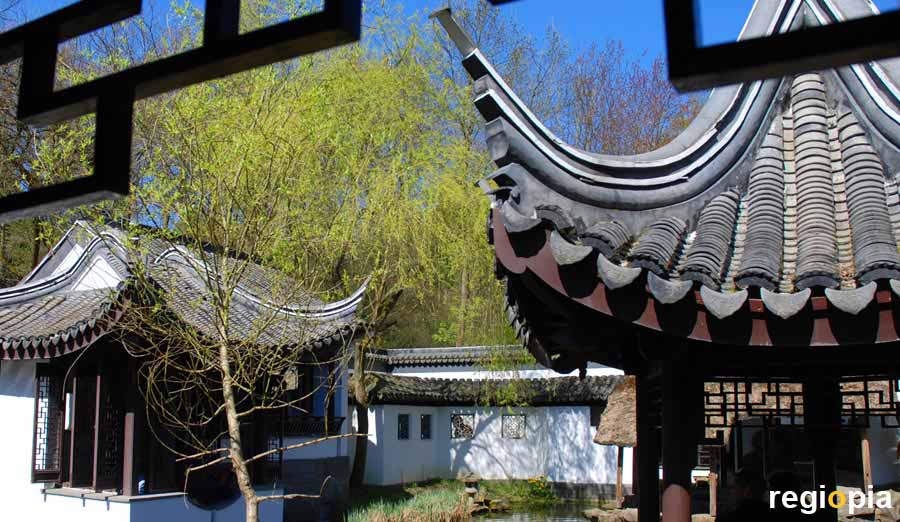
Chinese Garden Bochum
This charming Chinese Garden is located in the botanical garden of the Ruhr University in Bochum. The Qian Yuan was built as a gift by Tongji University from Shanghai in 1990. The project was supported financially by the Sparkasse Bochum. Planning and construction was carried out by Chinese specialists who also brought the materials from their home land. The name Qian Yuan refers to the poet Tao Yuanming (Tao Qian), who is known throughout China for the poem "Record from the peach blossom spring". The story is about a fisherman who follows a river to the source and finds a hidden paradise behind a crevice.
The Ruhr University is a brutalist concrete structure on the edge of the Ruhr valley. The botanical garden is on the slope below the university and the Chinese garden is hidden under trees in the lower part of the botanical garden.
The Qian Garden is entered via a bridge that bends in the pool by 90°, so that no evil spirits can follow. After leaving the entrance building behind, the view opens. The actual garden is a pond surrounded by white walls with various pavilions in Suzhou style.
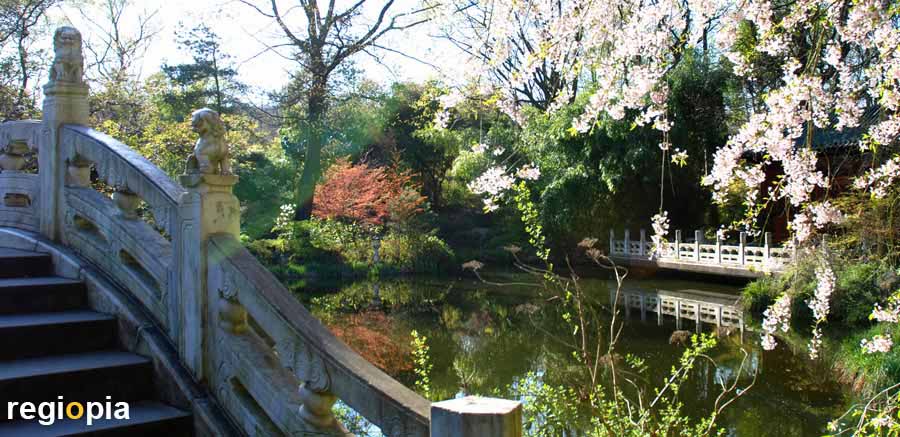
Chinese Garden Duisburg
The Chinese "Garden of the crane" is located inside the Duisburg Zoo. It is a gift from the Chinese partner city of Wuhan with financial support from Duisburg companies. The garden was built in 1988 by Chinese workers. You enter the garden through a gate, which is guarded by two marble lions. An open pavilion follows in which pictures and caligraphs are displayed. Now you can see the garden that was created around a pond. A white wall with green glazed bricks separates the Chinese garden from the zoological garden. Pavilions by the water and a marble bridge reveal their full beauty in spring, when numerous trees with their flower-covered branches enchant the garden.
Other Chinese gardens in Germany:
Chinese Garden Munich Chinese Garden Frankfurt Chinese Garden Berlin
Map of parks and natur in the Ruhr area
ads
Ruhr Travel Guide
ads
ads


